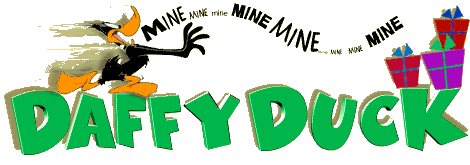![]()
 |
||
| Full Name: | Daffy Duck | |
| Date of Birth: | April-17th | |
|
Daffy Duck is definitely a bona fide "star," despite general
claims to the contrary. He has appeared in more than 120 cartoons since
his introduction in the 1937 short "Porky's Duck Hunt."
Daffy's appearance and frenetic, unpredictable personality have made him
immediately recognizable and a favorite with audiences around the world. In his first cartoon, "Porky's Duck Hunt," Daffy inverts the role of hunter and prey, thwarting Porky Pig's expectations and frustrating him until he finally waves a sheaf of papers at the duck and shouts, "Th-th-that's not in the script!" The hyperactive duck became an immediate hit and was christened "Daffy" in 1938 in the short titled, "Daffy Duck and Egghead." Daffy and Porky became an established team, and as their partnership developed, Daffy's initial insanity was tempered to a neurotic paranoia. He became less wildly untethered and more cunning and conniving. In Friz Freleng's `You Ought To Be in Pictures" (1940), Daffy convinces Porky to quit his steady job in cartoons to become "Bette Davis' leading man." When Porky leaves, the devious duck immediately tries to persuade the producer to give him Porky's starring roles and billing. Inevitably, Porky returns and Daffy's hopes are dashed. Daffy's aggressive and overbearing personality played well off Porky's shy and less confident demeanor, but Chuck Jones developed another more volatile combination: Daffy Duck and Bugs Bunny. Jones' Bugs of the 1950's was naturally cool and intelligent, and possessed great wit and quickness of thought. Daffy, previously known for his sense of unbridled frenzy, became a thinking duck, although most of his thinking centered around himself. "l may be a nasty little black duck," he confides to the audience, "but I'm a live little black duck!" Daffy strives to be level-headed and witty as Bugs but, try as he may, the fact that he does not succeed drives him crazy and propels the humor. Daffy's vanity, greed, haste and disregard for all warnings appearing before him invariably set him up for failure, and with each failure, he sets his goals even higher. In Jones "Rabbit Fire" (1951), "Rabbit Seasoning" (1952) and "Duck! Rabbit! Duck!" (1953) and Freleng's "A Star's Bored" (1956) and "Show Biz Bugs" (1957), the conflict between Daffy and Bugs grows into the Cartoon equivalent of an epic struggle -- with only Daffy left to do the struggling. This is the quality with which audiences identify; regardless of the cosmos' conspiracy against him, Daffy never gives up. In addition to headlining with a variety of co-stars in more than 120 cartoons during the last 50 years, Daffy has also starred in two feature length movies, two Saturday morning programs and two prime time television specials. In 1987, Daffy starred as an entrepreneurial paranormalist in the first Looney Tunes theatrical short in twenty years, "The Duxoris" The following year he was a feature player in "The Night of the "The Duck." Both of these shorts can now be seen as part of the feature length film "Daffy Duck's Quackbusters." Daffy's epic adventures can also be seen Saturday mornings on ABC's "The Bugs Bunny and Tweety Show;" weekdays on Fox's "Merrie Melodies Starring Bugs Bunny & Friends" and daily on Nickelodeon's "Looney Tunes." |
||